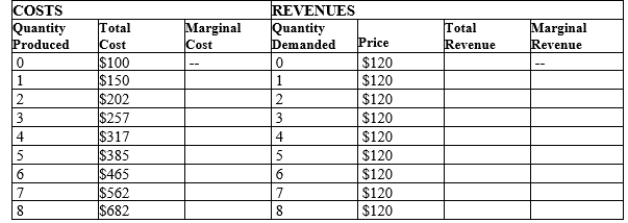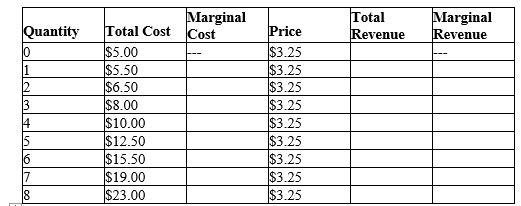A) sell all he wants at the going price, so he has little reason to charge less.
B) influence the market price by adjusting his output.
C) influence the profits earned by competing firms by adjusting his output.
D) All of the above are correct.
Correct Answer

verified
Correct Answer
verified
Multiple Choice
Suppose that a competitive market is initially in equilibrium. Then demand increases. If entering firms face the same costs as existing firms and sufficient resources are available for entering firms,
A) the long-run market supply curve will be upward sloping.
B) the long-run market supply curve will be perfectly elastic.
C) in the long run firms will suffer economic losses, leading them to exit the industry.
D) the number of firms will decrease, and the market will become a monopoly.
Correct Answer

verified
Correct Answer
verified
True/False
For a firm operating in a perfectly competitive industry, total revenue, marginal revenue, and average revenue are all equal.
Correct Answer

verified
Correct Answer
verified
Multiple Choice
Scenario 14-1 Assume a certain firm in a competitive market is producing Q = 1,000 units of output. At Q = 1,000, the firm's marginal cost equals $15 and its average total cost equals $11. The firm sells its output for $12 per unit. -Refer to Scenario 14-1. At Q = 999, the firm's total costs equal
A) $10,985.
B) $10,990.
C) $10,995.
D) $10,999.
Correct Answer

verified
Correct Answer
verified
True/False
A competitive firm's profit will be increasing as long as marginal revenue is greater than marginal cost.
Correct Answer

verified
Correct Answer
verified
True/False
The stable, long-run equilibrium in a competitive market occurs when the market price equals the lowest point on a firm's average total cost curve.
Correct Answer

verified
Correct Answer
verified
True/False
By comparing the marginal revenue and marginal cost from each unit produced, a firm in a competitive market can determine the profit-maximizing level of production.
Correct Answer

verified
Correct Answer
verified
Multiple Choice
Perfectly competitive markets are characterized by
A) conditions that discourage new firms from entering the market.
B) conditions that allow firms to determine how much they wish to produce, without influencing the market price.
C) conditions that presume that each firm produces a unique product.
D) conditions that force firms to advertise their product heavily, to compete with other producers.
Correct Answer

verified
Correct Answer
verified
Multiple Choice
Table 14-6
The following table presents cost and revenue information for a firm operating in a competitive industry.  -Refer to Table 14-6. What is the marginal revenue from selling the 3rd unit?
-Refer to Table 14-6. What is the marginal revenue from selling the 3rd unit?
A) $55
B) $120
C) $137
D) $140
Correct Answer

verified
Correct Answer
verified
Multiple Choice
Figure 14-1
Suppose that a firm in a competitive market has the following cost curves:  -Refer to Figure 14-1. If the market price rises above $6.30, the firm will earn
-Refer to Figure 14-1. If the market price rises above $6.30, the firm will earn
A) positive economic profits in the short run.
B) negative economic profits in the short run but remain in business.
C) negative economic profits and shut down.
D) zero economic profits in the short run.
Correct Answer

verified
Correct Answer
verified
Multiple Choice
Table 14-12  -Refer to Table 14-12. What is the marginal cost of the 8th unit?
-Refer to Table 14-12. What is the marginal cost of the 8th unit?
A) $0
B) $72.75
C) $120
D) $502
Correct Answer

verified
Correct Answer
verified
True/False
In the long run, if we observe firms in a competitive market earning economic profits, we know that this market is in long-run equilibrium.
Correct Answer

verified
Correct Answer
verified
Multiple Choice
Free entry means that
A) the government pays any entry costs for individual firms.
B) government-funded research lowers the costs of patents and other barriers to entry.
C) a firm's marginal cost is zero.
D) no legal barriers prevent a firm from entering an industry.
Correct Answer

verified
Correct Answer
verified
Multiple Choice
If a competitive firm is selling 900 units of its product at a price of $10 per unit and earning a positive profit, then
A) its total cost is more than $9,000.
B) its marginal revenue is less than $10.
C) its average total cost is less than $10.
D) the firm cannot be a competitive firm because competitive firms cannot earn positive profits.
Correct Answer

verified
Correct Answer
verified
Multiple Choice
A firm that shuts down temporarily has to pay
A) its variable costs but not its fixed costs.
B) its fixed costs but not its variable costs.
C) both its variable costs and its fixed costs.
D) neither its variable costs nor its fixed costs.
Correct Answer

verified
Correct Answer
verified
Multiple Choice
Which of the following firms is the closest to being a perfectly competitive firm?
A) the New York Yankees
B) Apple, Inc.
C) DeBeers diamond wholesalers
D) a wheat farmer in Kansas
Correct Answer

verified
Correct Answer
verified
Multiple Choice
Table 14-16
The table represents the demand information for a firm in a competitive market. 
-Refer to Table 14-16. For this firm, when output is equal to 12 units, average revenue is
-Refer to Table 14-16. For this firm, when output is equal to 12 units, average revenue is
A) $15.
B) $150.
C) always greater than marginal revenue.
D) decreasing.
Correct Answer

verified
Correct Answer
verified
Multiple Choice
Table 14-3
The table represents a demand curve faced by a firm in a competitive market.  -Refer to Table 14-3. For this firm, the price is
-Refer to Table 14-3. For this firm, the price is
A) $39.
B) $26.
C) $13.
D) $0.
Correct Answer

verified
Correct Answer
verified
Multiple Choice
Table 14-14
The following table presents cost and revenue information for Bob's bakery production and sales.  -Refer to Table 14-14. When Bob produces and sells the profit-maximizing quantity, how much profit does he earn?
-Refer to Table 14-14. When Bob produces and sells the profit-maximizing quantity, how much profit does he earn?
A) $0.25
B) $2.75
C) $4.00
D) $5.25
Correct Answer

verified
Correct Answer
verified
Multiple Choice
In a competitive market with free entry and exit, if all firms have the same cost structure, then
A) all firms will operate at their efficient scale in the short run.
B) all firms will operate at their efficient scale in the long run.
C) the price of the product will differ across firms.
D) Both a and b are correct.
Correct Answer

verified
Correct Answer
verified
Showing 421 - 440 of 604
Related Exams